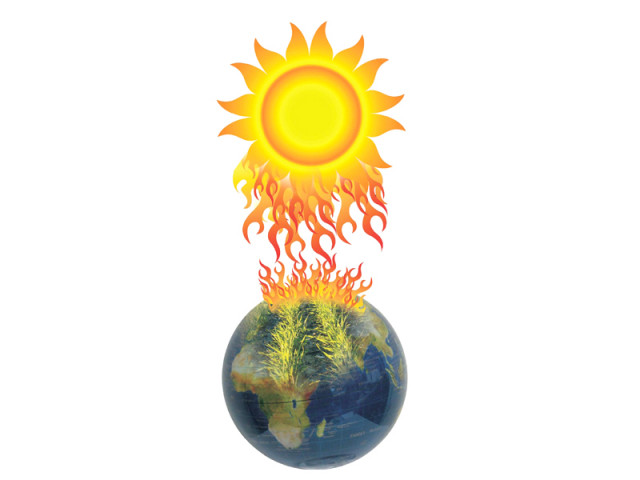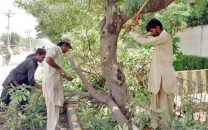Climate change: Crop yields and sowing patterns may change, says scientist
Strengthening of institutions to enact research-based policies stressed.

Crop yields and sowing and harvesting patterns may undergo striking changes in 20 to 30 years owing to rise in average temperatures and fall in fresh water reserves, Dr Pervaiz Amir, an agriculture and environment expert, told The Express Tribune. He was asked to access the likely impact of climate change on Pakistan in the near future.
The impact, he said, will vary across regions. In Punjab and Sindh, droughts will be more intense and yield of summer crops as well as fruits and vegetables may be substantially lower with rise in temperature levels.
In Northern Areas (Swat, Malakand, Gilgit, Hunza and parts of AJK), wheat, maize and rice yields will increase due to longer and hotter summer seasons.
Dr Amir said a likely repeat of 1998-2001 droughts in Balochistan over the coming years will take a heavy toll on crops, fruits and livestock production.
Pakistan has been included among countries likely to be most affected by climate change in Global Climate Risk Index 2012, a report by German Watch, a non-governmental organisation. The report released prior to the Durban climate change conference in 2011 examined the affect of extreme weather events worldwide from 1991-2010.
According to former environment minister Malik Amin Aslam, Pakistan stands to lose between $6 billion and $14 billion per annum if no measures are taken to deal with natural catastrophes triggered by climate change. The projection is based on the $9billion losses incurred during the 2010 summer floods.
Dr Amir believes the early impact of climate change is already apparent during summer months. “Lahore, Sargodha Mianwali, Larkana and Nurpur Thal were among 28 cities in the world that experienced record high temperatures in 2010,” he said.
With the mercury touching 53.5 °C (128.3 °F) on May 26, 2010, Mohenjo Daro in Sindh has had the highest temperature ever in Asia and fourth highest temperature ever in the world. Temperatures above 50 °C (122 °F) were recorded in 12 Pakistani cities in the summer of 2010.
Dr Amir warned that if no measures are taken to check carbon dioxide emissions, average temperatures in Pakistan will likely rise by 4°C to 6°C by the end of the century. The increase in average temperature for the globe will be around 2°C.
Water-intensive crops like sugarcane and cotton will be the worst affected by the climate change.
According to a World Bank study, as much as 30 per cent of the country’s current water reserves will deplete in 20 years. “The cost of production of these crops will surge if we do not formulate policies and guidelines on use of water for irrigation,” he adds.
At present, the only method in place to ration irrigation water is by increasing electricity tariffs and diesel prices during periods of drought.
Dr Amir predicts water shortage will take a toll on about 20 to 25 per cent of cultivable land in the Punjab and Sindh and render it unfit for agriculture.
This, he says, may require the population to reduce dependence on wheat and shift to use of coarse grains such as barley, sorghum, millets, oats and coarse rice. He says more farmers may shift from production of staples to cash crops.
Animal and crop diseases
Dr Amir said climate change will lead to changes in growth cycles of various microbes, pests, insects and fungi. These changes may make it difficult to maintain current yield levels in cross-pollinated crops (maize) and several fruits and fodders. The production of honey may also be affected as bees are likely to migrate to higher altitudes.
The environment expert said locust and stemrust will cause greater damage to crops with rise in temperature and humidity levels. He feared crop yields might go down by as much as 50 per cent owing to outbreak of these diseases in the Punjab and Sindh. He says changes in nitrogen-fixing bacteria may affect soil fertility. The incidence of dengue and Congo fevers and Hepatitis C will go up due to variations in temperature.
Glaciers
Dr Amir said glaciers should be watched very carefully for sudden and drastic changes. Melting of glaciers, glacial lake outburst floods (GLOF) and changes in in-flow of water in rivers will all impact population, especially those settled along river banks. He said new research and modeling techniques could help predict the impact of such activities.
He said as much as 40 per cent of the country’s glaciers may melt by the end of the century.
The Chinese Academy of Sciences has estimated significant melting activity in 50 and 75 per cent of glaciers in Asia and 80 per cent in the world, over this period.
Along with China, Nepal and India, Pakistan is ranked among the top five countries with potentially dangerous glaciers in a 2010 report by International Centre for Integrated Mountain Development (ICIMOD). Pakistan has had nine recorded GLOF incidents so far.
Way forward
Dr Amir said measures underway to tackle climate change and water scarcity were inadequate. If action was not accelerated, he said, economic growth and development would be adversely affected in the coming decades.
He said the country needed to build a new dam every six to seven years to sustain the economy.
None of the dams currently planned would be capable of making a contribution before 2020.
“There are at least nine sites in Pakistan with a power generation potential of over 60,000 megawatts,” he said. Dr Amir said there were reports and studies on issues related to climate change in Pakistan.
The pressing need was to implement their recommendations through sound policies. He sought strengthening of environment-related institutions to boost research on pressing issues and to monitor and penalise violations.
About adverse affects on agriculture and public health, he said engagement with communities was needed to control the damage.
Published in The Express Tribune, April 20th, 2012.



















COMMENTS
Comments are moderated and generally will be posted if they are on-topic and not abusive.
For more information, please see our Comments FAQ